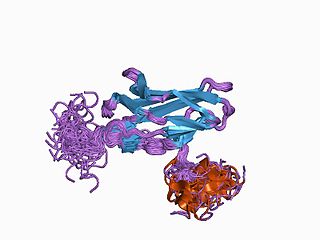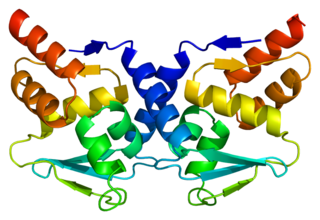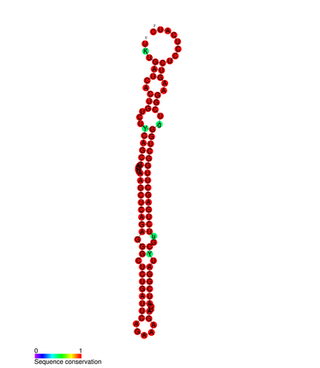B-cell lymphoma/leukemia 11A is a protein that in humans is encoded by the BCL11A gene. [5] [6] [7]
B-cell lymphoma/leukemia 11A is a protein that in humans is encoded by the BCL11A gene. [5] [6] [7]
The BCL11A gene encodes for a regulatory C2H2 type zinc-finger protein, that can bind to the DNA. Five alternatively spliced transcript variants of this gene, which encode distinct isoforms, have been reported. [7] The protein associates with the SWI/SNF complex, that regulates gene expression via chromatin remodeling. [8]
BCL11A is highly expressed in several hematopoietic lineages, and plays a role in the switch from γ- to β-globin expression during the fetal to adult erythropoiesis transition. [9]
Furthermore, BCL11A is expressed in the brain, where it forms a protein complex with CASK to regulate axon outgrowth and branching. [10] In the neocortex, BCL11A binds to the TBR1 regulatory region and inhibits the expression of TBR1. [11]
The corresponding Bcl11a mouse gene is a common site of retroviral integration in myeloid leukemia, and may function as a leukemia disease gene, in part, through its interaction with BCL6. During hematopoietic cell differentiation, this gene is down-regulated. It is possibly involved in lymphoma pathogenesis since translocations associated with B-cell malignancies also deregulates its expression. In addition, BCL11A has been found to play a role in the suppression of fetal hemoglobin production. Therapeutic strategies aimed at increasing fetal hemoglobin production in diseases such as beta thalassemia and sickle cell anemia by inhibiting BCL11A are currently being explored. [12] [13]
Furthermore, heterozygous de novo mutations in BCL11A have been identified in an intellectual disability disorder, accompanied with global developmental delay and autism spectrum disorder. [14] These mutations disrupt BCL11A homodimerization and transcriptional regulation.
BCL11A has also been identified as an important gene of interest in type-2 diabetes. Methylation of BCl11A has been hypothesized to contribute to type-2 diabetes risk, while BCL11a loss in a human islet model was demonstrated to result in an increase in insulin secretion. [15] [16]
BCL11A has been shown to interact with a number of proteins. BCL11A was initially discovered as a COUP-TFI interacting protein. [17] In the nucleus, BCL11A forms paraspeckles that co-localize with NONO. [14] In neurons, BCL11A interacts with CASK to regulate target genes. [10] Furthermore, BCL11A interacts with the neuron-specific protein TBR1, which is also implicated in intellectual disability and autism spectrum disorder. [18]

Bcl-2, encoded in humans by the BCL2 gene, is the founding member of the Bcl-2 family of regulator proteins that regulate cell death (apoptosis), by either inhibiting (anti-apoptotic) or inducing (pro-apoptotic) apoptosis. It was the first apoptosis regulator identified in any organism.
Myc is a family of regulator genes and proto-oncogenes that code for transcription factors. The Myc family consists of three related human genes: c-myc (MYC), l-myc (MYCL), and n-myc (MYCN). c-myc was the first gene to be discovered in this family, due to homology with the viral gene v-myc.

ETV6 protein is a transcription factor that in humans is encoded by the ETV6 gene. The ETV6 protein regulates the development and growth of diverse cell types, particularly those of hematological tissues. However, its gene, ETV6 frequently suffers various mutations that lead to an array of potentially lethal cancers, i.e., ETV6 is a clinically significant proto-oncogene in that it can fuse with other genes to drive the development and/or progression of certain cancers. However, ETV6 is also an anti-oncogene or tumor suppressor gene in that mutations in it that encode for a truncated and therefore inactive protein are also associated with certain types of cancers.

In genetics and molecular biology, a corepressor is a molecule that represses the expression of genes. In prokaryotes, corepressors are small molecules whereas in eukaryotes, corepressors are proteins. A corepressor does not directly bind to DNA, but instead indirectly regulates gene expression by binding to repressors.
Chromatin remodeling is the dynamic modification of chromatin architecture to allow access of condensed genomic DNA to the regulatory transcription machinery proteins, and thereby control gene expression. Such remodeling is principally carried out by 1) covalent histone modifications by specific enzymes, e.g., histone acetyltransferases (HATs), deacetylases, methyltransferases, and kinases, and 2) ATP-dependent chromatin remodeling complexes which either move, eject or restructure nucleosomes. Besides actively regulating gene expression, dynamic remodeling of chromatin imparts an epigenetic regulatory role in several key biological processes, egg cells DNA replication and repair; apoptosis; chromosome segregation as well as development and pluripotency. Aberrations in chromatin remodeling proteins are found to be associated with human diseases, including cancer. Targeting chromatin remodeling pathways is currently evolving as a major therapeutic strategy in the treatment of several cancers.

Runt-related transcription factor 1 (RUNX1) also known as acute myeloid leukemia 1 protein (AML1) or core-binding factor subunit alpha-2 (CBFA2) is a protein that in humans is encoded by the RUNX1 gene.

Bcl-6 is a protein that in humans is encoded by the BCL6 gene. BCL6 is a master transcription factor for regulation of T follicular helper cells proliferation. BCL6 has three evolutionary conserved structural domains. The interaction of these domains with corepressors allows for germinal center development and leads to B cell proliferation.

Zinc finger and BTB domain-containing protein 16 is a protein that in humans is encoded by the ZBTB16 gene.

Polycomb complex protein BMI-1 also known as polycomb group RING finger protein 4 (PCGF4) or RING finger protein 51 (RNF51) is a protein that in humans is encoded by the BMI1 gene. BMI1 is a polycomb ring finger oncogene.

B-cell lymphoma/leukemia 10 is a protein that in humans is encoded by the BCL10 gene. Like BCL2, BCL3, BCL5, BCL6, BCL7A, and BCL9, it has clinical significance in lymphoma.

ERG is an oncogene. ERG is a member of the ETS family of transcription factors. The ERG gene encodes for a protein, also called ERG, that functions as a transcriptional regulator. Genes in the ETS family regulate embryonic development, cell proliferation, differentiation, angiogenesis, inflammation, and apoptosis.

Interferon regulatory factor 4 (IRF4) also known as MUM1 is a protein that in humans is encoded by the IRF4 gene,. IRF4 functions as a key regulatory transcription factor in the development of human immune cells. The expression of IRF4 is essential for the differentiation of T lymphocytes and B lymphocytes as well as certain myeloid cells. Dysregulation of the IRF4 gene can result in IRF4 functioning either as an oncogene or a tumor-suppressor, depending on the context of the modification.

T-cell leukemia homeobox protein 1 is a protein that in humans is encoded by the TLX1 gene, which was initially named HOX11.

ID4 is a protein coding gene. In humans, it encodes for the protein known as DNA-binding protein inhibitor ID-4. This protein is known to be involved in the regulation of many cellular processes during both prenatal development and tumorigenesis. This is inclusive of embryonic cellular growth, senescence, cellular differentiation, apoptosis, and as an oncogene in angiogenesis.

BCL-6 corepressor is a protein that in humans is encoded by the BCOR gene.

B-cell lymphoma/leukemia 11B is a protein that in humans is encoded by the BCL11B gene.

Basic leucine zipper transcription factor, ATF-like, also known as BATF, is a protein which in humans is encoded by the BATF gene.

Programmed cell death protein 2 is a protein that in humans is encoded by the PDCD2 gene.

B-cell CLL/lymphoma 9 protein is a protein that in humans is encoded by the BCL9 gene.

mir-127 microRNA is a short non-coding RNA molecule with interesting overlapping gene structure. miR-127 functions to regulate the expression levels of genes involved in lung development, placental formation and apoptosis. Aberrant expression of miR-127 has been linked to different cancers.
This article incorporates text from the United States National Library of Medicine, which is in the public domain.